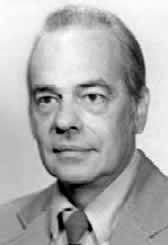Informatics Educational Institutions & Programs
Contents
Lawrence E. Glendenin | |
|---|---|
 | |
| Born | November 8, 1918 Bay City, Michigan, USA |
| Died | November 22, 2008 (aged 90) Illinois, USA |
| Nationality | American |
| Alma mater | University of Chicago, Massachusetts Institute of Technology |
| Known for | promethium |
| Awards | Glenn T. Seaborg Award for Nuclear Chemistry (1974) |
| Scientific career | |
| Fields | Chemistry (nuclear) |
| Institutions | Oak Ridge National Laboratory, Argonne National Laboratory |
Lawrence Elgin Glendenin (November 8, 1918 – November 22, 2008) was an American chemist who co-discovered the element promethium.[1]
Biography
Glendenin was born in Bay City, Michigan on November 8, 1918. He attended the University of Chicago, graduating in 1941.[2]
Clinton Laboratories

He worked as a chemist for the Clinton Laboratories (now Oak Ridge National Laboratory) during the World War II Manhattan Project, engaged in separating, identifying and characterizing the radioactive elements produced by nuclear fission.[2] In 1945, he, together with Jacob A. Marinsky and Charles D. Coryell, isolated the previously undocumented rare-earth element 61 (promethium).[1][3][4] Marinsky and Glendenin produced it both by extraction from fission products and by bombarding neodymium with neutrons.[4][5] They isolated it using ion-exchange chromatography.[4] Publication of the finding was delayed until later due to the war. In September 1947, Marinsky and Glendenin announced the discovery at a meeting of the American Chemical Society.[6][5] Upon the suggestion of Coryell's wife, the team named the new element for the titan god Prometheus, who stole fire from the gods and was punished for the act by Zeus.[4] They had also considered naming it "clintonium" for the facility where it was isolated.[7]
Szilárd petition
In 1945, Glendenin and 154 other Manhattan Project scientists signed the Szilárd petition. The petition urged President Harry S. Truman not to use the first atomic bomb "without restriction", urging him instead to "describe and demonstrate" its power and give Japan "the opportunity to consider the consequences of further refusal to surrender".[2][8][9]
Late career
In 1949, Glendenin earned his Ph.D. from the Massachusetts Institute of Technology. That same year he joined Argonne National Laboratory, where he worked until his retirement in 1985.[2]
He published extensively on the properties of fission products. He served as Scientific Secretary for the U.S. delegation to the Atoms for Peace Conference[2] and received the American Chemical Society's Glenn T. Seaborg Award for Nuclear Chemistry in 1974.[10]
Family and death
Glendenin was married for 63 years to Ethel Glendenin (née Long), who survived him at his death in November 2008. The couple were the parents of two daughters and one son.[2]
References
- ^ a b Weeks, Mary Elvira (1956). The discovery of the elements (6th ed.). Easton, PA: Journal of Chemical Education.
- ^ a b c d e f Dr. Lawrence Elgin Glendenin (obituary), Chicago Tribune, December 2, 2008.
- ^ Marshall, James L. Marshall; Marshall, Virginia R. Marshall (2016). "Rediscovery of the elements: The Rare Earths–The Last Member" (PDF). The Hexagon: 4–9. Retrieved 30 December 2019.
- ^ a b c d Reactor Chemistry – Discovery of Promethium Archived 2015-07-06 at the Wayback Machine, ORNL Review, Vol. 36, No. 1, 2003.
- ^ a b Nervous Elements, Time magazine, September 29, 1947.
- ^ Jacob A. Marinsky, Lawrence E. Glendenin, Charles D. Coryell: "The Chemical Identification of Radioisotopes of Neodymium and of Element 61", J. Am. Chem. Soc., 1947, 69 (11), pp. 2781–2785; doi:10.1021/ja01203a059.
- ^ Promethium Unbound: A New Element Archived 2008-12-06 at the Wayback Machine, ORNL Review Vol. 35, Nos. 3 and 4, 2002.
- ^ Oak Ridge petition, mid-July 1945, The Manhattan Project Heritage Preservation Association.
- ^ Howard Gest, The July 1945 Szilard Petition on the Atomic Bomb; Memoir by a signer in Oak Ridge Archived 2009-03-27 at the Wayback Machine, Indiana University of Pennsylvania, accessed December 5, 2008.
- ^ Glenn T. Seaborg Award for Nuclear Chemistry Archived 2011-07-24 at the Wayback Machine, American Chemical Society website, accessed December 2, 2008.

















